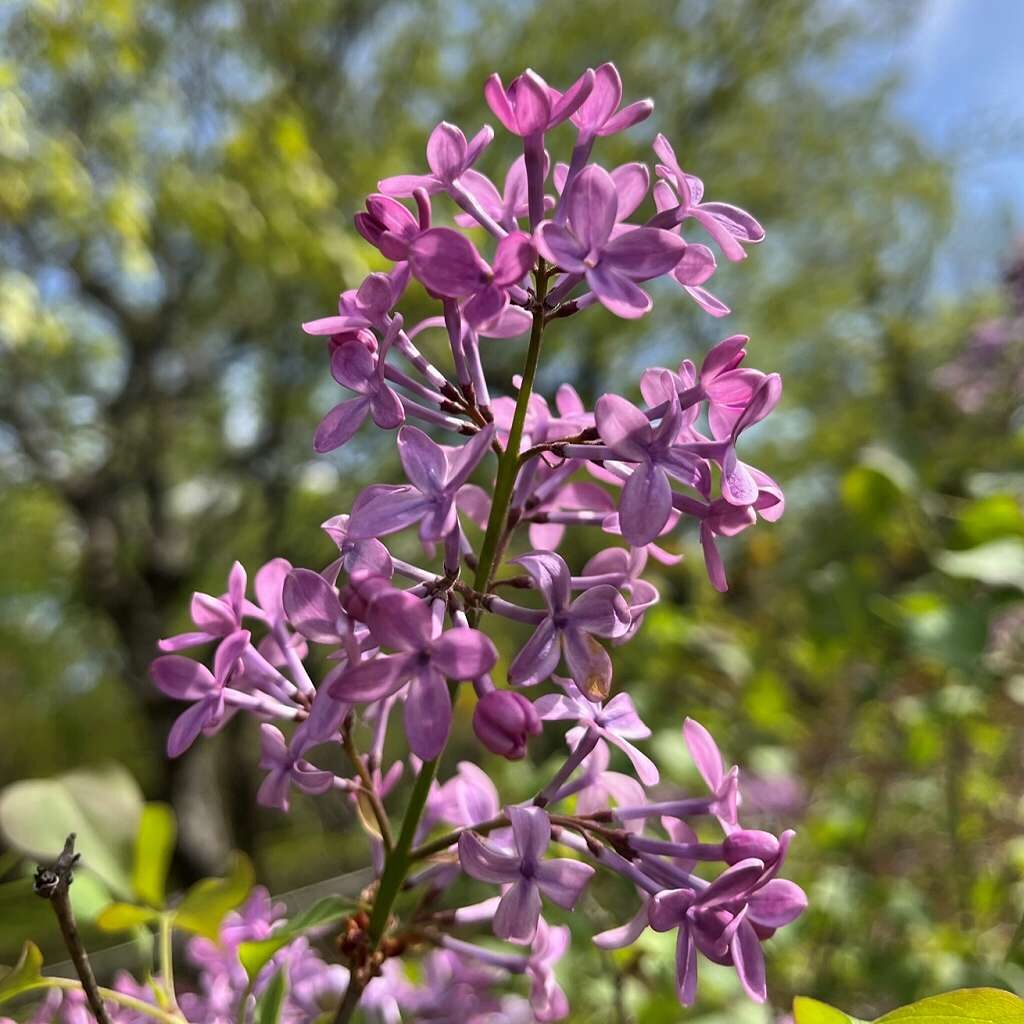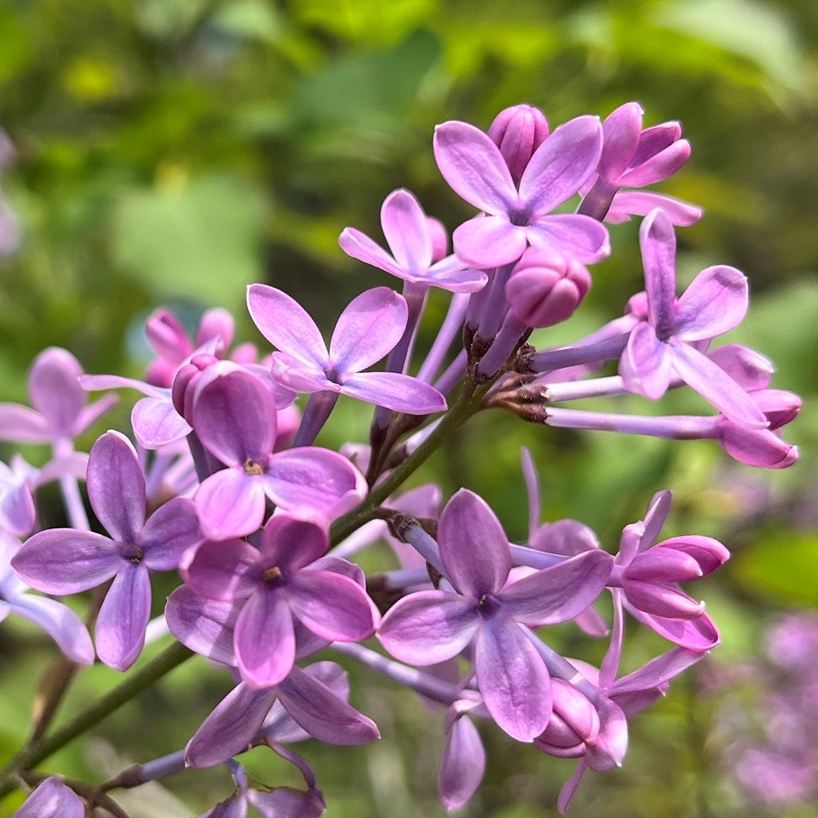芳香とともに夏の訪れを知らせてくれるライラックは花弁が4枚。「花弁が5枚の花を見つけると幸せになれる」という言い伝えがあります。
The lilac flower, which signals the arrival of summer with its fragrance, has 4 petals. There is a legend that “you can be happy if you find the flower with 5 petals”.
【仮名】ライラック, リラ, ムラサキハシドイ
【和名】紫丁香花
【英名】Lilac
【学名】Syringa vulgaris
【誕生】05/ 12, 05/ 18, 05/ 30, 06/ 12, 06/ 26
【開花】04, 05, 06月
【花色】White, Purple, Violet



ライラック
ライラックの生態
ライラックはモクセイ科の落葉樹です。原産地は欧州南東部。冷涼で風通しがよく、湿気の少ない環境を好みます。日本へは明治時代、アカシアとともに渡来し、大正時代に庭木として普及。北海道、本州の東北地域北部、高原地帯が栽培適地です。花言葉は「友情」「思い出」など。
ライラックの名前
ライラックは英名。語源はサンスクリット語で暗青色を意味する「ニラ」です。そのニラが転じて「リラ」に。フランスで「リラの咲くころ」は1年で一番良い季節を意味します。一方、北海道では初夏に寒さが戻ることを「リラ冷え」と表現。リラが転じてライラックになりました。
ライラックの和名
ライラックの和名は「紫色のハシドイ」という意味です。ハシドイは日本に自生する近縁種。同じように芳香があるものの、花は黄白色で、1カ月ほど遅く咲きます。名前の由来は花が枝先に集まるので「端集い」が転じたとも。俗称の「癩楢」は役に立たない用材といった意味です。
ライラックの属名
ライラックは日本語でハシドイ属ですが、ラテン語ではシリンガ属です。これは笛やパイプを意味する「シリンクス」に由来。古代ギリシャでは、ライラックの枝の髄をくり抜いて管状にし、羊飼いたちが笛として使いました。トルコではパイプに利用。役に立つ用材だったようです。
ライラックの形態
ライラックは枝先に多くの小花が密生して咲きます。小さな花冠は花弁が4枚。ただし、まれに花弁が5枚の花冠もあります。そんなときは「ラッキーライラック」と呼ばれる恋のおまじない。「花びらが5枚のライラックの花を見つけると幸せになれる」という言い伝えがあります。
ライラックの種類
ライラックの花色は品種によって様々です。「ルブラ」は落ち着きのある赤紫色、「ビオラケア」は清涼感のある青紫色、「アルバ」は早咲きの白色。かつては欧州で「白いライラックの花を家に持ち込むと不吉なことが起こる」という伝承もあったようですが、今は人気の花色です。
ライラックの利用
ライラックは寒さに強く、開花期間も長いため、おもに冷涼地での観賞樹として、庭園や公園、街路などに植えられています。夏の訪れを知らせてくれる花々と芳香。ライラックはジャスミンに似た甘い匂いで、ライラックアルコールという香気成分を含み、香水の原料にもなります。
lilac
Lilac is a deciduous tree of the Oleaceae family. The place of origin is southeastern Europe. They prefer a cool, well-ventilated, low-humidity environment. It came to Japan with Acacia in the Meiji era and became popular as a garden tree in the Taisho era. Hokkaido, the northern part of the Tohoku region and the plateau area of Honshu are suitable for planting. Flower language is “friendship”, “memories”, etc.
Lilac is an English name. The etymology is “Nila” which means dark blue in Sanskrit. Nila turns into “Lilas”. In France, “when the lilas blooms” means the best season of the year. On the other hand, in Hokkaido, the return of cold in early summer is referred to as “lilas cold”. Lilas turned into lilac.
The Japanese name for lilac means purple “Hashidoi: Japanese tree lilac”. Hashidoi is a closely related species of lilac that grows naturally in Japan. The flowers are yellowish white and bloom about a month late, although they are similarly fragrant. The origin of the name is that the flowers gather at the tip of the branch, so the “edge gathering” has changed. The popular name “Dosunara” means useless oak.
Lilac is the genus Lilac in Japanese, but the genus Syringa in Latin. This is derived from “Syrinx” which means whistle and pipe. In ancient Greece, The shepherds hollowed out the marrow of the lilac branches to make them tubular and used them as whistles. Used for pipes in Turkey. It seems that it was a useful material.
Lilac has many florets densely blooming at the tip of the branch. The small corolla has four petals. However, in rare cases, there is the corolla with five petals. In such a case, the magic of love called “Lucky Lilac”. There is a legend that “If you find the lilac flower with 5 petals, you will be happy.”
Lilac flower colors vary from variety to variety. “Rubra” is a calm reddish purple, “Violacea” is a refreshing bluish purple, and “Alba” is an early blooming white. There used to be a tradition in Europe that “bringing white lilac flowers into your house can cause ominous things,” but now it’s a popular flower color.
Lilac is resistant to the cold and has a long flowering period, so it is mainly planted in gardens, parks, and streets as an ornamental tree in cool regions. Flowers and fragrance that signal the arrival of summer. Lilac has a sweet odor similar to jasmine, contains an aroma component called lilac alcohol, and is also a raw material for perfumes.


